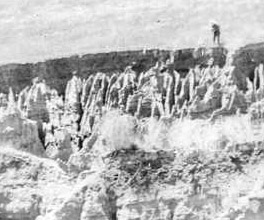Erosion
When John Murray first entered Port Phillip Bay in 1803, he wrote in his log book: 'the ground was hard and pleasant to walk on ... the soil is good as far as we may be judges'. Other settlers, however, were less impressed with what they saw of the terrain:
On some of the highest elevations an arid sea-sand is found, giving nourishment to no other vegetable than heath and fern. The bases of the hills consist of very coarse granite which is here found in every stage of formation, from grains scarcely adhering and crumbling into sand between the fingers...
– First Lieutenant Tuckey, of the HMS Calcutta
Cotter, R 2001, No place for a colony: Sullivan Bay, Sorrento and the Collins settlement, Essien, Melbourne, Vic.
Erosion is a natural process but human activity from early settlement on has helped increase erosion and has changed the ecosystems ability to sustain itself.
In Victoria, wind erosion occurs when hot, dry winds from the north-west lift topsoil and carry it into the atmosphere, where it stays until it rains.
During the extremely hot, dry weather of a drought, the wind blows away huge amounts of soil, causing dust storms. As the soil gradually blows away, farms become less and less productive, causing severe economic hardship.
Water erosion is caused by rain and water flowing over land and along watercourses. When waterside plants are removed, the soil gets washed away because the roots of the plants are no longer holding it together. Topsoil which has taken thousands of years to form can be washed away in a matter of minutes.
Farming, mining and the removal of vegetation have led to water erosion around many farming districts in Victoria's north-west. If nothing is done to fix the problem, flowing water will wash away river banks and carve huge cavities into adjoining land.
Coastal erosion is mostly a natural occurrence, although human activities can make it much worse. The building of piers and marinas, for example, change the tide's natural flow and cause beaches to erode. Walking over sand dunes can also cause erosion, as human footsteps destroy the vegetation holding the dune together.
Over 200 years since landing, the original Sullivan Bay settlement has been almost destroyed by erosion. Over 100 feet of coastline has fallen into the sea, including the house of commanding officer Lieutenant Collins, and those of other settlers.











